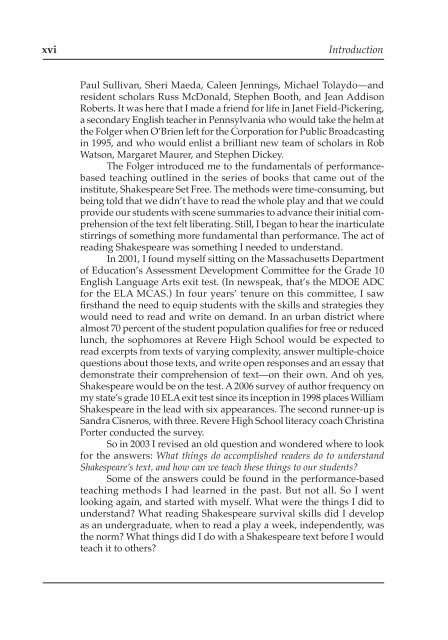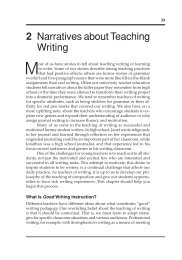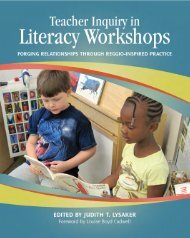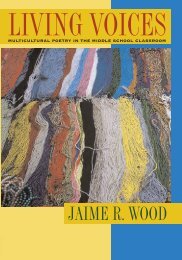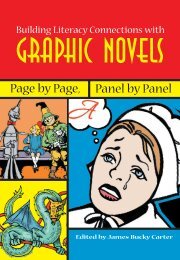reading Shakespeare
reading Shakespeare
reading Shakespeare
You also want an ePaper? Increase the reach of your titles
YUMPU automatically turns print PDFs into web optimized ePapers that Google loves.
xvi<br />
Introduction<br />
Paul Sullivan, Sheri Maeda, Caleen Jennings, Michael Tolaydo—and<br />
resident scholars Russ McDonald, Stephen Booth, and Jean Addison<br />
Roberts. It was here that I made a friend for life in Janet Field-Pickering,<br />
a secondary English teacher in Pennsylvania who would take the helm at<br />
the Folger when O’Brien left for the Corporation for Public Broadcasting<br />
in 1995, and who would enlist a brilliant new team of scholars in Rob<br />
Watson, Margaret Maurer, and Stephen Dickey.<br />
The Folger introduced me to the fundamentals of performancebased<br />
teaching outlined in the series of books that came out of the<br />
institute, <strong>Shakespeare</strong> Set Free. The methods were time-consuming, but<br />
being told that we didn’t have to read the whole play and that we could<br />
provide our students with scene summaries to advance their initial comprehension<br />
of the text felt liberating. Still, I began to hear the inarticulate<br />
stirrings of something more fundamental than performance. The act of<br />
<strong>reading</strong> <strong>Shakespeare</strong> was something I needed to understand.<br />
In 2001, I found myself sitting on the Massachusetts Department<br />
of Education’s Assessment Development Committee for the Grade 10<br />
English Language Arts exit test. (In newspeak, that’s the MDOE ADC<br />
for the ELA MCAS.) In four years’ tenure on this committee, I saw<br />
firsthand the need to equip students with the skills and strategies they<br />
would need to read and write on demand. In an urban district where<br />
almost 70 percent of the student population qualifies for free or reduced<br />
lunch, the sophomores at Revere High School would be expected to<br />
read excerpts from texts of varying complexity, answer multiple-choice<br />
questions about those texts, and write open responses and an essay that<br />
demonstrate their comprehension of text—on their own. And oh yes,<br />
<strong>Shakespeare</strong> would be on the test. A 2006 survey of author frequency on<br />
my state’s grade 10 ELA exit test since its inception in 1998 places William<br />
<strong>Shakespeare</strong> in the lead with six appearances. The second runner-up is<br />
Sandra Cisneros, with three. Revere High School literacy coach Christina<br />
Porter conducted the survey.<br />
So in 2003 I revised an old question and wondered where to look<br />
for the answers: What things do accomplished readers do to understand<br />
<strong>Shakespeare</strong>’s text, and how can we teach these things to our students<br />
Some of the answers could be found in the performance-based<br />
teaching methods I had learned in the past. But not all. So I went<br />
looking again, and started with myself. What were the things I did to<br />
understand What <strong>reading</strong> <strong>Shakespeare</strong> survival skills did I develop<br />
as an undergraduate, when to read a play a week, independently, was<br />
the norm What things did I do with a <strong>Shakespeare</strong> text before I would<br />
teach it to others


